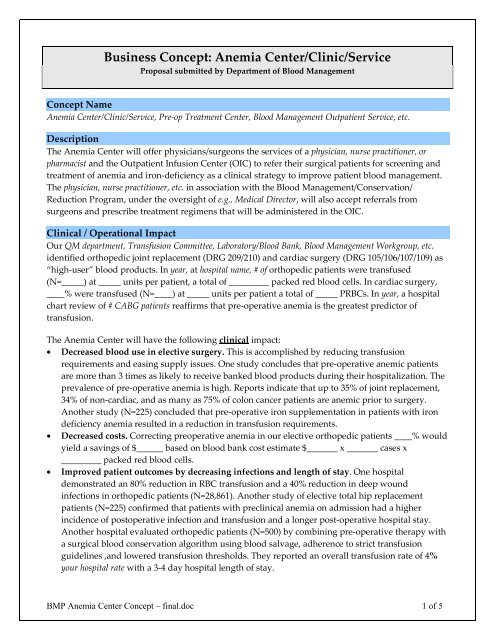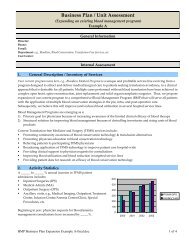Business Plan: Anemia Center - SABM.org
Business Plan: Anemia Center - SABM.org
Business Plan: Anemia Center - SABM.org
You also want an ePaper? Increase the reach of your titles
YUMPU automatically turns print PDFs into web optimized ePapers that Google loves.
<strong>Business</strong> Concept: <strong>Anemia</strong> <strong>Center</strong>/Clinic/Service<br />
Proposal submitted by Department of Blood Management<br />
Concept Name<br />
<strong>Anemia</strong> <strong>Center</strong>/Clinic/Service, Pre-op Treatment <strong>Center</strong>, Blood Management Outpatient Service, etc.<br />
Description<br />
The <strong>Anemia</strong> <strong>Center</strong> will offer physicians/surgeons the services of a physician, nurse practitioner, or<br />
pharmacist and the Outpatient Infusion <strong>Center</strong> (OIC) to refer their surgical patients for screening and<br />
treatment of anemia and iron-deficiency as a clinical strategy to improve patient blood management.<br />
The physician, nurse practitioner, etc. in association with the Blood Management/Conservation/<br />
Reduction Program, under the oversight of e.g., Medical Director, will also accept referrals from<br />
surgeons and prescribe treatment regimens that will be administered in the OIC.<br />
Clinical / Operational Impact<br />
Our QM department, Transfusion Committee, Laboratory/Blood Bank, Blood Management Workgroup, etc.<br />
identified orthopedic joint replacement (DRG 209/210) and cardiac surgery (DRG 105/106/107/109) as<br />
“high-user” blood products. In year, at hospital name, # of orthopedic patients were transfused<br />
(N=_____) at _____ units per patient, a total of _________ packed red blood cells. In cardiac surgery,<br />
____% were transfused (N=____) at _____ units per patient a total of _____ PRBCs. In year, a hospital<br />
chart review of # CABG patients reaffirms that pre-operative anemia is the greatest predictor of<br />
transfusion.<br />
The <strong>Anemia</strong> <strong>Center</strong> will have the following clinical impact:<br />
• Decreased blood use in elective surgery. This is accomplished by reducing transfusion<br />
requirements and easing supply issues. One study concludes that pre-operative anemic patients<br />
are more than 3 times as likely to receive banked blood products during their hospitalization. The<br />
prevalence of pre-operative anemia is high. Reports indicate that up to 35% of joint replacement,<br />
34% of non-cardiac, and as many as 75% of colon cancer patients are anemic prior to surgery.<br />
Another study (N=225) concluded that pre-operative iron supplementation in patients with iron<br />
deficiency anemia resulted in a reduction in transfusion requirements.<br />
• Decreased costs. Correcting preoperative anemia in our elective orthopedic patients ____% would<br />
yield a savings of $______ based on blood bank cost estimate $_______ x _______ cases x<br />
_________ packed red blood cells.<br />
• Improved patient outcomes by decreasing infections and length of stay. One hospital<br />
demonstrated an 80% reduction in RBC transfusion and a 40% reduction in deep wound<br />
infections in orthopedic patients (N=28,861). Another study of elective total hip replacement<br />
patients (N=225) confirmed that patients with preclinical anemia on admission had a higher<br />
incidence of postoperative infection and transfusion and a longer post-operative hospital stay.<br />
Another hospital evaluated orthopedic patients (N=500) by combining pre-operative therapy with<br />
a surgical blood conservation algorithm using blood salvage, adherence to strict transfusion<br />
guidelines ,and lowered transfusion thresholds. They reported an overall transfusion rate of 4%<br />
your hospital rate with a 3-4 day hospital length of stay.<br />
BMP <strong>Anemia</strong> <strong>Center</strong> Concept – final.doc 1 of 5
The <strong>Anemia</strong> <strong>Center</strong> will be an operational improvement of the current Blood Management<br />
Outpatient Service (BMOS).<br />
• Since year, the BMOS effectively eliminated the need for transfusions in pre-surgical anemic<br />
patients declining blood therapy by a small segment of committed physicians.<br />
• Growth to attract more patients was hampered by surgeon time constraints to screen their<br />
patients and prescribe early interventions, patient logistics, e.g., surgical referrals from outlying<br />
PCPs, and our lack of qualified personnel, e.g., physicians, nurse practitioner, to assess and<br />
prescribe treatment<br />
• <strong>Anemia</strong> <strong>Center</strong> will be a pro-active, viable alternative to reactive management of surgical blood<br />
loss (i.e., transfusion) and will expand to meet the needs of all elective anemic orthopedic, cardiac,<br />
and gynecologic surgical patients<br />
• The <strong>Anemia</strong> <strong>Center</strong> clinician physician, nurse practitioner, pharmacist and Blood Management<br />
Program staff will track referrals, subsequent surgical volumes, and measure clinical efficacy of<br />
the treatment regimen per protocol<br />
• Blood Management Program will be able to track blood PRBC usage in elective orthopedic joint<br />
replacement and open heart procedures.<br />
Patient/Physician/Staff Relations<br />
The <strong>Anemia</strong> <strong>Center</strong> will increase patient satisfaction:<br />
• The public is becoming increasingly aware of the risks associated with transfusions and the<br />
benefits of alternative blood management.<br />
• In a poll conducted by the <strong>Anemia</strong> Institute for Research and Education in 1999, 84% of<br />
consumer participants stated they would prefer an alternative to blood transfusion if it were<br />
available.<br />
The <strong>Anemia</strong> <strong>Center</strong> offers a practical solution to administrative concerns by:<br />
• Offsetting the increasing costs of blood products (10% annually).<br />
• Lessoning the strain on uncertain blood inventories due to a shrinking donor pool (only 5% of<br />
those eligible donate), while elderly surgical populations increase; a disaster could immobilize<br />
operating rooms across the city.<br />
• Improving reimbursement by shifting cost of anemia therapeutics from inpatient to outpatient<br />
treatment.<br />
The <strong>Anemia</strong> <strong>Center</strong> meets a growing need of physicians as they are:<br />
• Re-examining transfusion practice in view of safety issues, complications, and questionable<br />
efficacy of stored blood our hospital average is # days old.<br />
• Realizing that pre-operative anemia should be a contra-indication to elective surgery.<br />
• Appreciating the clinical advantages of pro-active blood management demonstrated by<br />
increasing number of iron infusions (3-5 daily in the OTC) administered to their High-risk OB<br />
and GYN patients.<br />
• Seeking more assistance from PBM department to participate in patient anemia discharge<br />
planning and preparing patients for future surgery.<br />
• Experiencing increased patient volumes while contending with greater restrictive policies and<br />
that screening and preoperative management of anemia is costly in terms of time and human<br />
resources.<br />
BMP <strong>Anemia</strong> <strong>Center</strong> Concept – final.doc 2 of 5
The <strong>Anemia</strong> <strong>Center</strong> will demonstrate to employees that:<br />
• Hospital mission statement is more than a slogan due to increasing awareness of blood<br />
conservation technology through Blood Management Program’s in-servicing and education.<br />
• Preoperative anemia is treatable and hospital is proactive.<br />
• Hospital name here supports best practices that include strategic patient blood management.<br />
Operational Infrastructure<br />
The <strong>Anemia</strong> <strong>Center</strong> will use (physician, nurse practitioner, or pharmacist) in their own office for<br />
preoperative work-up and evaluation and treatment in the Outpatient Infusion <strong>Center</strong>. The<br />
physicians will be on-call and collaborate with the Blood Management Department in patient tracking<br />
and research initiatives.<br />
Blood Management department will direct marketing and business development efforts to surgical<br />
practices and track <strong>Anemia</strong> <strong>Center</strong> assisted surgical cases. The Outpatient Infusion <strong>Center</strong> has space<br />
and staff to accommodate more volume; the Internal Medicine <strong>Center</strong> may use the Infusion <strong>Center</strong> for<br />
patient encounters, but will not require a permanent office.<br />
Growth<br />
A modest growth in orthopedic and cardiac surgical volumes is anticipated as the <strong>Anemia</strong> <strong>Center</strong><br />
enhances name of hospital hospital’s reputation for commitment to high-quality care among medical<br />
staff and referring physicians. Surgical cases scheduled at other hospitals may be diverted here as a<br />
result of the <strong>Anemia</strong> <strong>Center</strong> and the continuity of inpatient care provided through the Blood<br />
Management Program clinical resources. The <strong>Anemia</strong> <strong>Center</strong> will also bolster the services of the CV,<br />
Ortho, and GYN surgeons, as well as integrate the OB/GYN, Family Practice, and Surgery residency<br />
programs (if a teaching hospital) in order to optimize blood management for their patients scheduled<br />
for elective surgery.<br />
Financial Impact<br />
The cost per annum for the <strong>Anemia</strong> <strong>Center</strong> is $___________ for (per physician, nurse practitioner;<br />
contract fee or employed clinician). <strong>Business</strong> development and marketing costs will be borne by the<br />
(BMP and Public Relations departments). Cost will be offset by:<br />
• Savings in reduced blood usage in orthopedic joint replacement surgery<br />
Using our current blood bank estimates, the cost of delivering PRBCs in DRG 209/210 in year<br />
would have been $________ (________ units at $____ per unit). The unit cost includes<br />
acquisition, lab tests, type and cross matching, nursing costs and tubing but does not include<br />
indirect costs such as increased resource consumption and LOS in transfused patients. Estimating<br />
that ___% of orthopedic patients suffer pre-operative anemia, then # patients (___% of ______)<br />
were anemic. Correcting anemia in 50% of this population at a transfusion rate of # units per<br />
patient at $_____ per unit would yield a cost-savings of $_________ alone.<br />
• Potential savings from reduced blood use in elective cardiac and gynecologic surgery is<br />
anticipated with an <strong>Anemia</strong> <strong>Center</strong> assessment and early interventional anemia management.<br />
• Improving reimbursement profile by cost-shifting from inpatient to outpatient treatment as<br />
inpatient utilization is typically absorbed in the DRG.<br />
BMP <strong>Anemia</strong> <strong>Center</strong> Concept – final.doc 3 of 5
Background<br />
<strong>Business</strong> Proposal <strong>Anemia</strong> <strong>Center</strong> Financial Impact Appendix<br />
PBMC will utilize the Outpatient Treatment <strong>Center</strong> (OTC) and require the hiring of one (1) FTE<br />
Patient Representative. The cost per annum for the Patient Representative is $50,000. <strong>Business</strong><br />
development and marketing costs will be borne by the Blood Conservation Management (BCM)<br />
department.<br />
The cost will be directly offset by savings. According to the 6 month Banner Good Samaritan Medical<br />
<strong>Center</strong> (BGSMC) analysis of 242 orthopedic joint replacement surgeries in 2007, correcting<br />
preoperative anemia in 38 patients would have yielded a savings of $192,960 alone (see following chart).<br />
This is determined by the following:<br />
1. Eliminating the need for red blood cell transfusion: Sonora Quest Laboratory 2008 cost<br />
estimates to transfuse one unit of red blood cells ($852) at an average of 1.93 units per<br />
transfused patient would yield a 12-month savings of $100,195.<br />
2. Reducing the hospital length of stay: Correcting preoperative anemia in 13 hip replacement<br />
patients would have reduced length of stay by 2 days (6.7 transfused versus 4.4 nontransfused);<br />
thus Finance Department estimate of $892 per ortho-bed day 4 would yield a 12month<br />
savings of $46,384.<br />
3. Improving patient throughput by two days will yield a savings of $46,384.<br />
Another key economic advantage is drug cost reimbursement. Outpatient cost for anemia therapy is<br />
reimbursable, whereas inpatient utilization of red blood cell cost (up to three units) is absorbed in the<br />
Diagnostic Related Group (DRG). Therefore, establishing an Orthopedic Preoperative Blood<br />
Management <strong>Center</strong> greatly improves the reimbursement profile.<br />
Red Blood Cell Utilization in Orthopedic Total Joint Replacement 1H 2007<br />
Department of Blood Conservation Medicine – Banner Good Samaritan Medical <strong>Center</strong><br />
Total<br />
patients<br />
Pts<br />
Tx'd % Tx<br />
Units/<br />
Tx Pt<br />
BMP <strong>Anemia</strong> <strong>Center</strong> Concept – final.doc 4 of 5<br />
Units/<br />
Pt<br />
Red<br />
Blood<br />
Cells<br />
Tx<br />
LOS<br />
Tx<br />
LOS<br />
Non-<br />
Tx<br />
%<br />
Preop<br />
<strong>Anemia</strong><br />
% Preop<br />
<strong>Anemia</strong><br />
Transfused<br />
Total knee arthroplasty 136 22 16 1.72 0.28 38 4.9 4.3 20 30 8<br />
Total knee arthroplasty x 2 14 9 64 2.2 1.4 20 6.3 5.4 29 100 9<br />
Total hip arthroplasty 92 32 34 2 0.7 64 6.7 4.4 34 68 13<br />
# Pts<br />
treatable<br />
Preop<br />
anemia<br />
Totals 242 63 26 1.93 0.5 122 30<br />
Assumptions:<br />
1. Cost to deliver one RBC<br />
Unit $852<br />
2. Avg COS on Day 4 $892<br />
3. Tx predicts LOS in THA<br />
Strategy:<br />
Eliminate RBC Tx by<br />
6 months<br />
12<br />
months<br />
correcting pre-op anemia 30 Pts<br />
2<br />
1.93 66 $50,098 $100,195<br />
Reduce LOS (THA only) 13 Pts days $1784 $23, 192 $46,384<br />
Improve Pt Throughput<br />
2<br />
(THA only) 13 pts days $1784 $23,192 $46,384<br />
Cost Savings $192,960
References<br />
Garcia-Erce JA, Cuenca J, Munoz M, et al. Perioperative stimulation of erythropoiesis with<br />
intravenous iron and erythropoietin reduces transfusion requirements in patients with hip fracture. A<br />
prospective observational study. Vox Sang, 2005;88(4):235-243<br />
Dunne JR, Malone D, Tracy JK, Gannon C, Napolitano, LM, et al. Peroperative anemia: an<br />
independent risk factor for infection, mortality, and resource utilization in surgery. J Surg Res.<br />
2002;102:237-244<br />
Shander A, Knight K, Thurer, R, Adamson J, Spence R. Prevalence and outcomes of anemia in<br />
surgery: a systematic review of the literature. Am J Med. 2004;116(suppl 7A):58S-69S<br />
Pierson JL, Hannon TJ, Earles DR. A blood conservation algorithm to reduce blood transfusions after<br />
total hip and knee arthroplasty. J Bone Joint Surg Am. 2004;86-A:1512-1518<br />
Slappendel R, Dirksen R, Weber EW, van der Schaaf DB. An algorithm to reduce allogeneic red blood<br />
cell transfusions for major orthopedic surgery. Acta Orthop Scand. 2003;74:569-575<br />
Goodnough LT, Shander A, Spivak, JL, et al. Detection, evaluation, and management of anemia in the<br />
elective surgical patient. Anesth Analg. 2005;101:1858-1861<br />
Freedman J, Luke K, Monga, S, Escobar M, et al. A provincial program of blood conservation: The<br />
Ontario Transfusion Coordinators (ONTraC). Transfusion and Apheresis Science 2005;33:343-349<br />
BMP <strong>Anemia</strong> <strong>Center</strong> Concept – final.doc 5 of 5
















